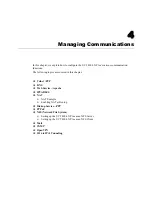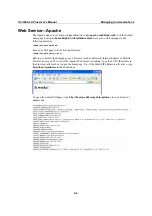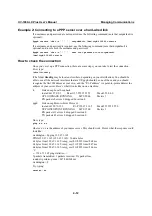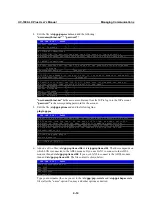
UC-7400-LX Plus User’s Manual
Managing Communications
4-12
Example 2: Connecting to a PPP server over a hard-wired link
If a username and password are not required, use the following command (note that noipdefault is
optional):
#pppd connect ‘chat –v“ “ “ “ ‘ noipdefault /dev/ttyM0 19200 crtscts
If a username and password is required, use the following command (note that noipdefault is
optional, and root is both the username and password):
#pppd connect ‘chat –v“ “ “ “ ‘ user root password root noipdefault
/dev/ttyM0 19200 crtscts
How to check the connection
Once you’ve set up a PPP connection, there are some steps you can take to test the connection.
First, type:
/sbin/ifconfig
(The folder
ifconfig
may be located elsewhere, depending on your distribution.) You should be
able to see all the network interfaces that are UP. ppp0 should be one of them, and you should
recognize the first IP address as your own, and the “P-t-P address” (or point-to-point address) the
address of your server. Here’s what it looks like on one machine:
lo
Link encap Local Loopback
inet addr 127.0.0.1
Bcast 127.255.255.255
Mask 255.0.0.0
UP LOOPBACK RUNNING
MTU 2000
Metric 1
RX packets 0 errors 0 dropped 0 overrun 0
ppp0
Link encap Point-to-Point Protocol
inet addr 192.76.32.3
P-t-P 129.67.1.165
Mask 255.255.255.0
UP POINTOPOINT RUNNING
MTU 1500
Metric 1
RX packets 33 errors 0 dropped 0 overrun 0
TX packets 42 errors 0 dropped 0 overrun 0
Now, type:
ping z.z.z.z
where z.z.z.z is the address of your name server. This should work. Here’s what the response could
look like:
waddington:~$p ping 129.67.1.165
PING 129.67.1.165 (129.67.1.165): 56 data bytes
64 bytes from 129.67.1.165: icmp_seq=0 ttl=225 time=268 ms
64 bytes from 129.67.1.165: icmp_seq=1 ttl=225 time=247 ms
64 bytes from 129.67.1.165: icmp_seq=2 ttl=225 time=266 ms
^C
--- 129.67.1.165 ping statistics ---
3 packets transmitted, 3 packets received, 0% packet loss
round-trip min/avg/max = 247/260/268 ms
waddington:~$
Try typing:
netstat –nr
















































